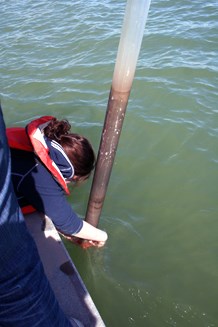|
Long-term Limnological and Aquatic Resource Monitoring for Lakes Mead and Mohave 
Photo by Michael Rosen, USGS
Sediment cores taken in 1998 have been examined for anthropogenic and natural organic and inorganic contaminants (Covay and Beck 2001; Rosen and Van Metre 2009). In addition, sediment from Las Vegas Wash (the main tributary from Las Vegas) has also been examined for contaminants (Covay and Leiker 1998). These studies found numerous organic compounds associated with urban runoff, industrial contaminants from erosion of the Basic Management Incorporated (BMI) site on Las Vegas Wash, and compounds associated with tertiary treated wastewater effluent, although few compounds were greater than Canadian sediment quality guidelines (Rosen and Van Metre 2009). In contrast to Lake Mead, remarkably little sediment has accumulated in Lake Mohave since its impoundment in 1953 (Foster 2004). Lake Powell (within Glen Canyon National Recreation Area) and other upstream reservoirs trap virtually all of the sediment transported by the Colorado River. The small amount of fine-grained sediment, which has accumulated, tends to occur in the deepest parts of the lake within sheltered areas along the edges of the drownedStrategic Fundamental Objectives
Management questions best answered by monitoring:
What is the status and trend of sediment delivery at tributaries? What is the status and trend of contaminants in sediments? (See also Category 3). more How does sediment distribution affect spawning potential and reproductive success of sensitive species? (See also Category 2). How effective are the new Las Vegas Wash wetlands in keeping contaminants out of Las Vegas Bay (see also Category 3. Stressors)? What is the effect of dredging or other maintenance activities on contaminant release from sediment? (See also Category 3). Management questions best answered by research: How do sediments serve as nutrient and contaminant traps or sinks and how do they affect productivity? What happens (e.g., microbial degradation, transport, compaction etc.) to contaminants in sediment? Are quagga mussels and other invasive species affecting sediment dynamics or vice versa? (See also Category 3). How do sediments and contaminants interact with the lower part of the food web? (See also Category 2). What is the role of sediment transport in relation to native fish spawning and fish habitat (see also Category 2. Fish and Aquatic Biota)? Where do sediments accumulate in greatest abundance? Are there places where contaminants accumulate? What is the fate and transport of contaminants? Is there a subsurface barrier? What is the relationship between suspended sediment and the aquatic food web and success of razorback sucker (see also Category 2. Fish and Aquatic Biota)? How does turbidity vary seasonally? What pathogen/sediment associations are present and what causes pathogen remobilization into the water column? How are the inputs of metals changed over time and place by anthropogenic (e.g., dams, manganese mining), atmospheric (climate change), or other natural actions? How do wastewater delivery systems impact sediments? |
Last updated: February 28, 2015
